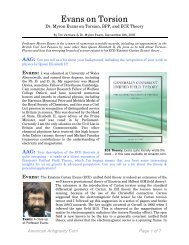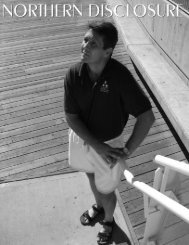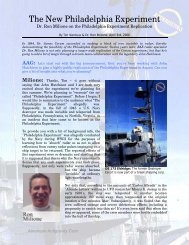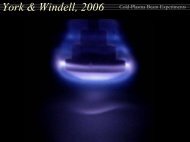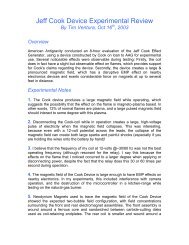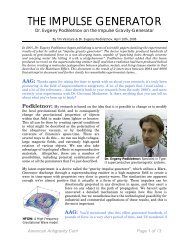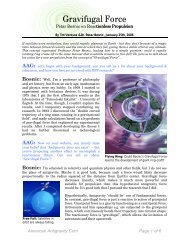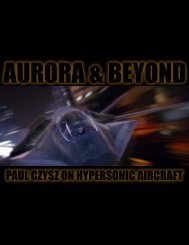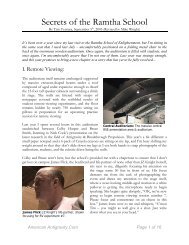Inertial Propulsion in Russia
Inertial Propulsion in Russia
Inertial Propulsion in Russia
You also want an ePaper? Increase the reach of your titles
YUMPU automatically turns print PDFs into web optimized ePapers that Google loves.
<strong>Inertial</strong> <strong>Propulsion</strong> <strong>in</strong> <strong>Russia</strong>Dr. Gennady Shipov on Torsion Physics & <strong>Inertial</strong> <strong>Propulsion</strong>By Tim Ventura & Dr. Gennady Shipov, April 18th, 2006Last month, Dr. Gennady Shipov unveiled a new <strong>in</strong>ertial propulsion drive developed by <strong>Russia</strong>n<strong>in</strong>ventor Vladimir Tolch<strong>in</strong>, add<strong>in</strong>g to a grow<strong>in</strong>g body of <strong>Inertial</strong> <strong>Propulsion</strong> & Torsion-Physics researchrevisit<strong>in</strong>g the basics of mechanical off-center rotators. He jo<strong>in</strong>s us to talk about several of the lead<strong>in</strong>gcontenders <strong>in</strong> <strong>Russia</strong>n <strong>in</strong>ertial-drive technology, <strong>in</strong>clud<strong>in</strong>g a device by Valery Menshikov scheduled fortest<strong>in</strong>g this year by the <strong>Russia</strong>n Space Agency…AAG: Let’s start out with the big news for 2006 -- last month you unveiled a new <strong>in</strong>ertialpropulsiondevice created by Vladimir Tolch<strong>in</strong> that uses an off-center rotator design todemonstrate forward thrust on a low-friction surface. I'm wonder<strong>in</strong>g if Tolch<strong>in</strong>'s device isderived from your theoretical research <strong>in</strong> Torsion Physics, or if it’s simply a serendipitous f<strong>in</strong>dbased on pr<strong>in</strong>ciples similar to those <strong>in</strong> your research?Shipov: Well, my theoretical research <strong>in</strong> Torsion-Physicshas really developed irrespective of Tolch<strong>in</strong>’s <strong>in</strong>vention. Forme, the Torsion-Physics research has really <strong>in</strong>volvedcont<strong>in</strong>u<strong>in</strong>g and expand<strong>in</strong>g research <strong>in</strong>to E<strong>in</strong>ste<strong>in</strong>'s UnifiedField Theory, and it’s led me to the realization that it’s possibleto derive an additional, fourth-generalization of Newtonianmechanics, which I’ve dubbed “Descartesian mechanics”.In the Descartesian mechanics model, any movement isconsidered rotation - even l<strong>in</strong>ear motion, because it occurs <strong>in</strong>curved space. This is obviously the case <strong>in</strong> cosmology, where aplanet’s l<strong>in</strong>ear motion <strong>in</strong> the curved space of the sun’s gravitywellforms a stable circular orbit. This pr<strong>in</strong>ciple provides uswith the opportunity generate net propulsive force with<strong>in</strong>novative mechanical systems. The <strong>in</strong>vention wedemonstrated by Tolch<strong>in</strong> is such a system…Dr. Gennady Shipov: Worldrenownedtheoretical physicist.AAG: We received several questions about the recentvideos ask<strong>in</strong>g whether the devices be<strong>in</strong>g demonstrated are comparable to the classic "Dean-Drive" off-center rotator technology, and whether it might compare at all to the more recent ExBMach-Lorentz Thruster technology be<strong>in</strong>g developed by James Woodward's group?Shipov: For a device like this, the <strong>in</strong>ventor needs to start by ask<strong>in</strong>g a very fundamentalquestion -- “what is the force creat<strong>in</strong>g this movement?” In the case of the “Dean-Drive” themotive force is a comb<strong>in</strong>ation of friction and <strong>in</strong>ertia. Thus, if we remove the friction, the devicewill not move.Unfortunately, I’m not familiar with the details of Dr. Woodward’s experimentation. However,the question above mentions that Lorentz's electromagnetic force plays a role, presumablymak<strong>in</strong>g external electromagnetic fields a design requirement. My question then is whetherdevice move <strong>in</strong> space if it generates its own external fields…American Antigravity.Com Page 1 of 8
The propulsive force <strong>in</strong> the Tolch<strong>in</strong> device orig<strong>in</strong>ates from <strong>in</strong>ertial force, which <strong>in</strong> Descartesianmechanics are generated by Ricci torsion fields (four types of <strong>in</strong>ertial forces are now known). It’swell known that <strong>in</strong>ertial forces don’t obey Newton’s third law of motion -- therefore these forcesoperate <strong>in</strong>side of an isolated mechanical system to move the center of mass. Even to this day,many scientists tra<strong>in</strong>ed <strong>in</strong> the traditional laws of Newtonian mechanics have difficulty accept<strong>in</strong>gthis fact.AAG: One of the skeptic's claims aboutmechanical reactionless drives like Tolch<strong>in</strong>'s is thatthey only run when one axis of motion isconstra<strong>in</strong>ed -- such as be<strong>in</strong>g placed on a flatsurface, even if the surface has no friction. Do youbelieve that his device will work givenunconstra<strong>in</strong>ed 3-dimensional motion, such as <strong>in</strong> afree-fall or space environment?Shipov: Well, it’s more than just a belief – Iknow without a doubt that the Tolch<strong>in</strong> device’spropulsive force isn’t simply dependent onconstra<strong>in</strong>ed rotary motion. I’m fully confident thatit will move <strong>in</strong> space more effectively than it alreadydoes <strong>in</strong> air, on water, or on the Earth’s surface.AAG: As I understand th<strong>in</strong>gs, Torsion theorywas very big dur<strong>in</strong>g the days of the Soviet Union,<strong>Inertial</strong> <strong>Propulsion</strong>: Forward motion on alow-friction surface built by Vladimir Tolch<strong>in</strong>.but that it was suppressed by the <strong>Russia</strong>n scientific establishment to ga<strong>in</strong> favor with westernscientists dur<strong>in</strong>g the 1990's. This led to what seemed to be an unfounded negative reputationperception for Torsion-field research, as well as skeptical articles about "Torsion fraud". Givenrecent announcements about BPP technologies from <strong>Russia</strong>, do you th<strong>in</strong>k that the attitudes arebeg<strong>in</strong>n<strong>in</strong>g to change back <strong>in</strong> favor of this research?Shipov: Torsion Physics began <strong>in</strong> <strong>Russia</strong> <strong>in</strong> 1980 with the creation of devices aptly named“torsion generators”. These devices didn’t orig<strong>in</strong>ate from with<strong>in</strong> the official scientificcommunity, and thus weren’t accepted or recognized by that community – a prejudicial bias thatstill cont<strong>in</strong>ues to this day. Historically speak<strong>in</strong>g, this k<strong>in</strong>d of long-term opposition between old& new ideas used to be a rarity, but it’s all too common these days both <strong>in</strong> <strong>Russia</strong> as well as theUnited States.The acceptance of torsion physics will w<strong>in</strong> not come simply from recognition by the scientificcommunity, but <strong>in</strong>stead from the widespread social & economic needs that drive commercialadoption of these torsion-based technologies. Issues like energy & transportation have becomeuniversal problems and if they’re left unsolved we’re fac<strong>in</strong>g a potential apocalypse.AAG: Nearly one year ago, Novosti published an article about a reactionless drive be<strong>in</strong>gdeveloped for test<strong>in</strong>g <strong>in</strong> space by Dr. Valery Menshikov -- he claimed that it generated nearly 28-grams of thrust for satellite stationkeep<strong>in</strong>g through the action of an <strong>in</strong>ternal rotat<strong>in</strong>g liquid.Have you heard of this story, and do you believe that it may be a torsion-effect, givenMenshikov's claim of "not know<strong>in</strong>g the means of propulsion"?Shipov: Menshikov is the director of the “Scientific Research Institute for Space Systems”(SRISS). I know him personally, and <strong>in</strong> fact I’ve even written a scientific report on <strong>in</strong>ertialAmerican Antigravity.Com Page 2 of 8
propulsion for him. One week ago ademonstration of Menshikov’s reactionlessdrivewas broadcast on Central <strong>Russia</strong>nTelevision – this is the same reactionlessdrive be<strong>in</strong>g developed for space-duty atSRISS. Menshikov and others has published abook on the topic, and half the material <strong>in</strong> itwas dedicated to my earlier research… mynewer work has diverged from his researchefforts, however.AAG: To follow up on the earlier question,I <strong>in</strong>terviewed Alex Frolov last year, whoclaimed that the device Menshikov wasprepar<strong>in</strong>g to test was actually <strong>in</strong>vented by Dr.Spartak Poliakov. I'm wonder<strong>in</strong>g if you mightbe familiar with this story at all, and have anycomments on <strong>in</strong>dependent or open-sourceBPP research <strong>in</strong> <strong>Russia</strong>?Shipov: Yes, the device was <strong>in</strong> factorig<strong>in</strong>ally <strong>in</strong>vented by Poliakov, who based iton ideas and schematics of Austrian <strong>in</strong>ventorVictor Shauberger. Unfortunately, Poliakovdidn’t have good legal protection, soMenshikov simply took away his <strong>in</strong>vention.After all, Menshikov is a government official.This unfair situation was the reason forcreation of the private research centers <strong>in</strong><strong>Russia</strong> which are engaged new torsion physicsand torsion technologies.AAG: Do you know if the <strong>Russia</strong>nscientific establishment is putt<strong>in</strong>g anyresources <strong>in</strong>to develop<strong>in</strong>g Breakthrough<strong>Propulsion</strong> Technologies of any sort? It seemsthat NASA is refocus<strong>in</strong>g on Apollo-erarockets, and I'm hop<strong>in</strong>g this news about boththe Tolch<strong>in</strong> device and Menshikov's test are<strong>in</strong>dicators that <strong>Russia</strong> is mak<strong>in</strong>g real progress<strong>in</strong> this area. Do you know if BPP is becom<strong>in</strong>ga funded endeavor <strong>in</strong> <strong>Russia</strong>, and whatdirection <strong>Russia</strong>'s space-program is headedtechnologically?Shipov: As I’ve said before, <strong>in</strong> <strong>Russia</strong>there’s a struggle between the old statescience establishment and the emerg<strong>in</strong>g fieldof torsion physics. The government officialsresponsible for ma<strong>in</strong>ta<strong>in</strong><strong>in</strong>g the entrenchedviews of the establishment will stop at noth<strong>in</strong>gThe Poliakov Vortex-Drive: In April 2005, the<strong>Russia</strong>n State-News Agency Novosti ran anarticle stat<strong>in</strong>g that Dr. Valery Menshikov ofMoscow’s R&D Institute of Space Systems<strong>in</strong>tended to test an ‘<strong>in</strong>ertialess drive’ to providelong-term space propulsion. A liquid or solidstatepropulsive mass moves along a presettornado-shaped trajectory <strong>in</strong>side this eng<strong>in</strong>e,thereby ensur<strong>in</strong>g susta<strong>in</strong>able propulsion.The device be<strong>in</strong>g tested is a variation on the“Vortex-Drive” – an <strong>in</strong>ertialess propulsion systemdeveloped by Dr. Spartak M. Poliakov, aGraduate of Kish<strong>in</strong>ev State University, and anexperimental physicist with over 47 years <strong>in</strong> theelectronics <strong>in</strong>dustry. He has authored over 50scientific papers, and a recent book entitled“Introduction to Experimental Gravitonics”. Thephoto above was taken by Alexander Frolovdur<strong>in</strong>g a 1998 visit to Poliakov’s laboratory.Vortex-Drive: Alex Frolov’s enhanced drivesystem based on Poliakov’s orig<strong>in</strong>al design.American Antigravity.Com Page 3 of 8
to do so: they garble the facts, level all sorts ofaccusations aga<strong>in</strong>st myself and otherscientists <strong>in</strong>vestigat<strong>in</strong>g torsion phenomena,and publish slanderous warn<strong>in</strong>gs about“Torsion fraud” to scare the public.As a result of these entrenched <strong>in</strong>terests, Ispent considerable time <strong>in</strong> Thailandconduct<strong>in</strong>g my research simply to avoid the<strong>Russia</strong>n political environment. Thoseattitudes are beg<strong>in</strong>n<strong>in</strong>g to change, however --private capital has become <strong>in</strong>terested <strong>in</strong>torsion science and this research is once aga<strong>in</strong>mov<strong>in</strong>g forward through private sectorfund<strong>in</strong>g. This renewed <strong>in</strong>terest <strong>in</strong> Torsionphysics wasn’t lost on the governmentbureaucrats, though – while they still speaknegatively about Torsion Physics research,they’re also simultaneously develop<strong>in</strong>g it forBreakthrough <strong>Propulsion</strong> applications withprojects like the one <strong>in</strong>volv<strong>in</strong>g ValeryMenshikov. Thus, that puts long-termresearch efforts like m<strong>in</strong>e <strong>in</strong>to competitionwith the <strong>Russia</strong>n government, which is acommercial challenge that I welcome.AAG: After the end of the Cold-War, Ith<strong>in</strong>k that most Americans assumed that we'dbe the solid leader <strong>in</strong> the space-<strong>in</strong>dustry, butI'm wonder<strong>in</strong>g how our space-program looksfrom the <strong>Russia</strong>n perspective. After all,America seems to have largely turned its backon basic research <strong>in</strong>to breakthroughpropulsion physics, and <strong>Russia</strong> seems towork<strong>in</strong>g towards revitaliz<strong>in</strong>g its spaceprogram. Do you th<strong>in</strong>k we'll see <strong>Russia</strong>overtake the USA <strong>in</strong> space research &technology <strong>in</strong> the near future?The 4-D Gyroscope: This reactionless <strong>in</strong>ertialpropulsion device was constructed & rigorouslytested by Dr. Gennady Shipov as a conceptualproof for applied Descartesian Mechanics theory.The 4-D Gyroscope uses a special device called amotor-break to convert momentum from asp<strong>in</strong>n<strong>in</strong>g rotor <strong>in</strong>side the device <strong>in</strong>to forwardthrust through a series of <strong>in</strong>ternal-impacts.Shipov’s experimentation <strong>in</strong>volved operat<strong>in</strong>g thedevice both with and without the brake to plottrue <strong>in</strong>ertial propulsion versus unwantedacceleration from friction <strong>in</strong> wheels, bear<strong>in</strong>gs, etcPowered by only a small electric motor to sp<strong>in</strong>the rotors, Shipov’s experimental results<strong>in</strong>dicated a net average velocity about 10centimeters per second. Additionally, dur<strong>in</strong>g eachcycle the body retreats 2 cm backwards andmoves 12 cm forward, as show below.Shipov: I th<strong>in</strong>k that the time has comefor both the United States and <strong>Russia</strong> to setcompetition aside and focus on collaborative& cooperative endeavors to overcome thechallenges that face all of us <strong>in</strong> the 21 stcentury. Today’s social & scientific challengeshave a global impact, and the solutions oftomorrow will benefit the whole of humanityas a result.<strong>Russia</strong> easily outstrips the USA <strong>in</strong> thedevelopment of torsion technologies – ourtechnology is at least 15 years ahead of similarefforts <strong>in</strong> the United States. This is the resultExperimental Data: A comparison of <strong>in</strong>ertialversus frictional acceleration for the gyroscope.American Antigravity.Com Page 4 of 8
of a new scientific paradigm emerg<strong>in</strong>g fromresearch <strong>in</strong>to the “Theory of Physical Vacuum” –and while it still isn’t recognized as official sciencewith<strong>in</strong> <strong>Russia</strong>, it’s mak<strong>in</strong>g more of an impact herethan <strong>in</strong> the West, where it rema<strong>in</strong>s completelyunknown.Accept<strong>in</strong>g this new scientific paradigm won’t beeasy: it requires more than the sheer <strong>in</strong>telligence offigures like Roger Penrose. To fully appreciate themean<strong>in</strong>g & implications of this new paradigm, itrequires that special brand of <strong>in</strong>tuitive <strong>in</strong>sightembodied by visionary th<strong>in</strong>kers like E<strong>in</strong>ste<strong>in</strong>. Inother words, it requires a higher level ofconsciousness & awareness, which becomes moreThornson Drive: This drive shown mov<strong>in</strong>ga canoo on still water at 1mph <strong>in</strong> 1990.than just a philosophical argument or scientific model – it will be a transformative processallow<strong>in</strong>g us to reach the full potential of civilization <strong>in</strong> the 21 st century.AAG: Ok, any quick tests that garage-t<strong>in</strong>kerers can do to demonstrate Torsion Theoryphysics? I've read that Torsion fields are supposed to conditionally change the resistance ofsome wire-junctions, and of course your reactionless thruster, but anyth<strong>in</strong>g simple to get thepublic excited?Shipov: Unfortunately, the days of garage-t<strong>in</strong>kerers achiev<strong>in</strong>g breakthroughs <strong>in</strong> TorsionPhysics are long gone – today’s Torsion technologies are highly complex devices demand<strong>in</strong>gproper safety precautions and precision measurements <strong>in</strong> the laboratory.The ma<strong>in</strong>stream media has saturated the public with so many fictional stories aboutbreakthrough technologies that it’s becom<strong>in</strong>g difficult to build <strong>in</strong>terest <strong>in</strong> real-life breakthroughresearch, but those breakthroughs are nonetheless out there be<strong>in</strong>g achieved every day.One simple experiment that I’ve found excit<strong>in</strong>g is a change <strong>in</strong> the molecular structure of metalsafter exposure to Torsion radiation, which was conducted by Dr. Rustum Roy at PennsylvaniaState University. I was certa<strong>in</strong>ly surprised when I first heard about this experiment, but <strong>in</strong>another sense it’s one of many surpris<strong>in</strong>g developments to come out of Torsion Physics research.You know, given the solid experimental results that Torsion research produces, what I reallyf<strong>in</strong>d surpris<strong>in</strong>g & puzzl<strong>in</strong>g is the cultural resistance <strong>in</strong> the scientific community to this research,given that our research <strong>in</strong> <strong>Russia</strong> has been produc<strong>in</strong>g results & technologies for over 20 years.AAG: Have you ever considered us<strong>in</strong>g a purelyelectromagnetic system to generate reactionlesstorsion-based thrust? What attracts you to themechanical means of test<strong>in</strong>g this theory?Thornson Drive: Inventor BrandsonThornson shown open<strong>in</strong>g the drive apparatusShipov: The problem with us<strong>in</strong>g anelectromagnetic system is that the underly<strong>in</strong>gphysical pr<strong>in</strong>ciples beh<strong>in</strong>d all physics – and all realbreakthroughs <strong>in</strong> physics – always beg<strong>in</strong> with themechanics of a physical system, as shown <strong>in</strong> boththe Special and General Theory of Relativity as wellas <strong>in</strong> Quantum Mechanics.American Antigravity.Com Page 5 of 8
Therefore, my research began at the mostfundamental and consequently most difficult level– with a basis <strong>in</strong> physical mechanics. Generallyspeak<strong>in</strong>g, if a new discovery is made <strong>in</strong> mechanics,then it will have consequences <strong>in</strong> all aspects ofphysics, <strong>in</strong>clud<strong>in</strong>g electrodynamics. I believe thatit’s important to <strong>in</strong>troduce a new pr<strong>in</strong>ciple <strong>in</strong>tophysical mechanics first, and then to build moreelaborate models on top of that foundation, whichis what I’ve done with Descartesian mechanics.Certa<strong>in</strong>ly one of our future goals is to construct areactionless drive system based on electromagneticfields, but it is necessary to beg<strong>in</strong> with a strongfoundation <strong>in</strong> physical mechanics first.Tolch<strong>in</strong> Drive: Test<strong>in</strong>g <strong>in</strong> water produces aforward thrust <strong>in</strong> a low-friction medium.AAG: Build<strong>in</strong>g off the question about the implementation of your research, I'm wonder<strong>in</strong>ghow many potential paths there might be to create reactionless thrust of one type or anotherus<strong>in</strong>g Torsion-physics as a foundation?Shipov: I th<strong>in</strong>k that there are many potential avenues to explore with future research. Wecan draw from a number of <strong>in</strong>ventions <strong>in</strong> this area developed by <strong>in</strong>ventors work<strong>in</strong>g outside ofthe scientific establishment, such as Cook, Tolch<strong>in</strong>, Thornson, and others. The fact that they’redo<strong>in</strong>g this work outside of the ma<strong>in</strong>stream is an sign of the times, and it should providescientists with the <strong>in</strong>spiration to provide a scientific foundation for their <strong>in</strong>novations. S<strong>in</strong>ce it’simpossible to expla<strong>in</strong> these <strong>in</strong>ventions on the basis of contemporary scientific doctr<strong>in</strong>e, itbecomes necessary to <strong>in</strong>volve a new Scientific Paradigm - the Theory of Physical Vacuum(Descartesian's mechanics) -- <strong>in</strong> which Torsion Fields play the basic role.AAG: In essence, most of the def<strong>in</strong>itions that I've seen for a Torsion-field also call it a "sp<strong>in</strong>field",and it seems to be associated with all sorts of rotation that we see throughout nature. Isthere a difference between torsion and simple angular momentum, and if not, does that meanwe can expect to f<strong>in</strong>d Torsion Effects <strong>in</strong> all rotat<strong>in</strong>g systems?Shipov: You’re absolutely right. From my po<strong>in</strong>t of view, Torsion Fields truly are theUnify<strong>in</strong>g Field that E<strong>in</strong>ste<strong>in</strong> said would unite all of the other fields and <strong>in</strong>teractions <strong>in</strong> physics.In the science of mechanics, Torsion Fields prove through fields of <strong>in</strong>ertia that the phenomenonof <strong>in</strong>ertia is more fundamental than even the gravitational phenomena. In quantum mechanics,<strong>in</strong>ertial fields def<strong>in</strong>e the wave functions that describe physical phenomenon <strong>in</strong> a truly universalway. Thus, <strong>in</strong> The Theory of Physical Vacuum, wecan reduce all physical motion to rotation – andthus we can realize vision of DescartesianMechanics.Pendulum Test: In this experiment, thedrive still produces net forward thrust.AAG: Have you ever considered work<strong>in</strong>g withsp<strong>in</strong> on a molecular or atomic level? I've heardrumors about experiments be<strong>in</strong>g proposed us<strong>in</strong>g a"nuclear magnetic resonance" technique that<strong>in</strong>volves align<strong>in</strong>g the atomic sp<strong>in</strong> throughout abulk-sample of a material, and tne us<strong>in</strong>g magneticor electrical forces to create a reactionlessAmerican Antigravity.Com Page 6 of 8
propulsion much like a form of m<strong>in</strong>i gyroscopic precession. Do you th<strong>in</strong>k this approach mightmerit further <strong>in</strong>vestigation?Shipov: We conducted research atMoscow State University’s Department ofPhysics on the <strong>in</strong>fluence of torsionradiations on Messbauer effect. I’veprovided a graphic show<strong>in</strong>g the results ofthis research, which as you can see werequite <strong>in</strong>terest<strong>in</strong>g.Our experiment clearly demonstrated thatnuclear magnetic resonance feels the<strong>in</strong>fluence of torsion-field radiation. We planon return<strong>in</strong>g to this process to createcontrolled fields of <strong>in</strong>ertia (or torsion), byalign<strong>in</strong>g and controll<strong>in</strong>g atomic nuclear sp<strong>in</strong>us<strong>in</strong>g NMR. It is very fruitful idea.AAG: I'm not sure if you've heard therecent ESA announcement, but Dr. Mart<strong>in</strong>Tajmar appears to have found a "self-sp<strong>in</strong>"effect <strong>in</strong> rotat<strong>in</strong>g superconductorscomparable to the Lense-Thirr<strong>in</strong>g framedragg<strong>in</strong>geffect under <strong>in</strong>vestigation byGravity Probe-B. While relativity theoryseems to support this as an angular-vectorfor an otherwise well-expla<strong>in</strong>ed effect, I'mwonder<strong>in</strong>g if Torsion physics might offersome <strong>in</strong>sight <strong>in</strong>to how to capitalize on thiseffect?Nuclear Magnetic Resonance: Test<strong>in</strong>g the effectsof torsion fields at Moscow State UniversityShipov: The rotation of physical objects is described by Descartesian mechanics, <strong>in</strong> whichany rotation is connected with torsion field. Therefore, the effects that you’re describ<strong>in</strong>g can bedescribed <strong>in</strong> detail us<strong>in</strong>g Torsion field theory.AAG: Let's talk experimentalists: this self-sp<strong>in</strong> idea has been a part of several reported<strong>in</strong>dependent projects, such as the controversial "Searl Effect Generator" for over 60 years. BothSearl <strong>in</strong> Great Brita<strong>in</strong> and God<strong>in</strong> & Rosch<strong>in</strong> <strong>in</strong> <strong>Russia</strong> claimed to have seen this effect <strong>in</strong> sp<strong>in</strong>n<strong>in</strong>gNeodymium magnet systems and I'm wonder<strong>in</strong>g if you have any thoughts on whether this is agravitational, torsion, or frame-dragg<strong>in</strong>g effect?Shipov: It’s well known that the bulk magnetic properties of various materials aresubstantially def<strong>in</strong>ed by sp<strong>in</strong> of electrons. In turn, the sp<strong>in</strong> of those electrons is connected with amechanical rotation that generates a torsion field. Therefore, <strong>in</strong> magnetic materials where theelectron sp<strong>in</strong>s are mostly aligned, the magnetic field emanat<strong>in</strong>g from the material always hasaccompany<strong>in</strong>g it torsion field. This phenomenon is deeply rooted <strong>in</strong> the theory of torsion fieldsand can only be understood <strong>in</strong> view of this theory.American Antigravity.Com Page 7 of 8
AAG: Have you ever spoken with Sergei God<strong>in</strong>or Vladimir Rosch<strong>in</strong>? I'm wonder<strong>in</strong>g if you haveany op<strong>in</strong>ions about their research or credibility --either from personal experience or professionalop<strong>in</strong>ion?Shipov: Several years ago I met with God<strong>in</strong>and Rosch<strong>in</strong>, but I didn’t get to see their <strong>in</strong>vention<strong>in</strong> operation. They have only heuristic reasons howit is possible to create antigravitational propulsion,but they don’t currently have a work<strong>in</strong>g device.AAG: Back to bus<strong>in</strong>ess -- its' been four monthss<strong>in</strong>ce our last <strong>in</strong>terview, and I'm wonder<strong>in</strong>g howyour bus<strong>in</strong>ess is go<strong>in</strong>g? I took the experimentalvideos from last month to be an <strong>in</strong>dicator that youwere mak<strong>in</strong>g real scientific progress, and hop<strong>in</strong>gthat general <strong>in</strong>terest <strong>in</strong> this area has been grow<strong>in</strong>gfor you. Are th<strong>in</strong>gs progress<strong>in</strong>g as you'd hoped onthe bus<strong>in</strong>ess front?Shipov: Let's talk about that at a later timewhen our project has progressed further.God<strong>in</strong> & Rosch<strong>in</strong>: A Homopolar Motor <strong>in</strong>New Energy Technologies Magaz<strong>in</strong>e.AAG: Let's close out with what's next: will you be releas<strong>in</strong>g new papers, video-clips, orexperimental results this year, and if so, what might we look forward to see<strong>in</strong>g?Shipov: The results of fundamental physics research belong to all humanity – I plan onpublish<strong>in</strong>g the results of future research as we conduct it. I th<strong>in</strong>k that <strong>in</strong> the near future we’ll bedo<strong>in</strong>g another experimental video demonstrat<strong>in</strong>g a reactionless propulsion device climb<strong>in</strong>g upan <strong>in</strong>cl<strong>in</strong>ed plane <strong>in</strong> defiance of gravity.Dr. Gennady Shipov is a world-renowned theoretical physicist liv<strong>in</strong>g <strong>in</strong> Moscow, <strong>Russia</strong>. Hiseducation <strong>in</strong>cludes both an M.A. and PhD <strong>in</strong> Theoretical Physics, and his research <strong>in</strong>cludes 54scientific papers, 7 monographs, and numerous prestigious scientific and directorial roles with<strong>in</strong>the <strong>Russia</strong>n scientific establishment. He is also a found<strong>in</strong>g member of the <strong>Russia</strong>n Association ofGravitational Sciences, and currently serves as the Director of the Science Center of Physics ofVacuum <strong>in</strong> Moscow. You can visit his website onl<strong>in</strong>e at: http://www.shipov.comAmerican Antigravity.Com Page 8 of 8



